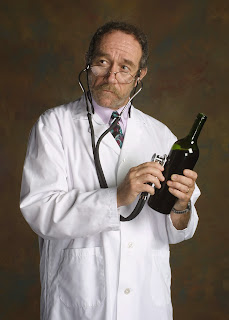No doubt there will be many a bottle
of bubbly uncorked for New Year celebrations. Here are a couple of tips on
serving it. It is best served slightly chilled at around 10º C. Ideally that
means about 15 – 20 minutes in an ice bucket, half filled with water and ice. Romantic
too! Alternately, down below in your fridge for about 30 – 40 minutes will do.
Never serve too cold or chill it in the freezer. Use only flutes, the elongated
narrow glasses with a smaller surface area opening. These maintain the bubbles
the longest. And never, ever chill your stemware. This will kill the bubbles instantly
upon pouring. Following these simple rules will provide best results. Remember to
sip responsibly and Happy New Year.
Monday, December 30, 2013
Thursday, December 26, 2013
Holiday Cheer
Happy
holidays to one and all! This is the time of year to get together with loved
ones and friends and sip a little something special to celebrate the season.
It’s a great opportunity to pull out those rare bottles that you’ve been
hanging on to for just such an occasion. Something meaningful or really
different should suffice. Utilize your best glassware too. Make the experience
one that will live in your memory forever. Be sure to
provide some food alongside to temper the alcohol and never drive or let
someone else drive if they have been drinking. It’s a magical time of year and
it’s easy to get carried away, so just remember to party responsibly. Enjoy
yourself and play safe.
Monday, December 16, 2013
Bitters
With the holiday season in full swing
and overindulgence a given, here’s a more sophisticated way to ease that
stuffed feeling rather than loosening your clothing. Try some “bitters”. They’re traditionally a
liquid concoction made from alcohol and water, usually flavoured with
botanicals like aromatic herbs, roots, bark, flowers and even fruit. You may
know them better as cocktail flavouring agents, but for centuries, people have utilized
bitters for medicinal purposes, at the end of a meal to ease the tummy.
Available from all over the world and sold at liquor stores and occasionally
grocery stores, they’re just the things to have around at this time of year.
When you feel too full, they could come in very handy.
Monday, December 9, 2013
Healthier Wine
Ever wonder if some wines are
healthier for you than others? One might suspect those with lower alcohol and
less sugar would be, especially since these contain more calories. As much as
that may be the case, science has shown that red wines with the darkest colour
are. They contain more anthocyanins (plant-based antioxidants like resveratrol)
which reduce risks of heart disease and stroke. Dark coloured reds usually come
from warmer, sunnier climates because the grapes are exposed to more ultraviolet
light with higher heat units and more intense sunlight. So if you’re looking
for a healthier wine to serve to guests this holiday season, try choosing those
from a warmer climate, perhaps closer to the equator.
Monday, December 2, 2013
Bottle Shapes
Wine
generally comes packaged in several, different shaped bottles. The Bordelaise
(straight sides, distinctive shoulders) is used for Bordeaux blends or its
individual varietals (Cabernet, Merlot, etc.). The Burgundy (sturdy, heavier,
gently sloping shoulders) is mostly used for Chardonnay and Pinot Noir. The
“flute” or “hock” (long, narrow) used primarily in Alsace and Germany, tends to
house Riesling and Gewürztraminer everywhere. Finally, the Rhone (similar to
the Burgundy, but slimmer with less girth) is utilized for Rhone-type grapes
like Syrah, Grenache, Mourvedre, Cinsault, Viognier and their blends. Bottle
shape plays no role other than to distinguish one wine/varietal/style from
another
Subscribe to:
Comments (Atom)




